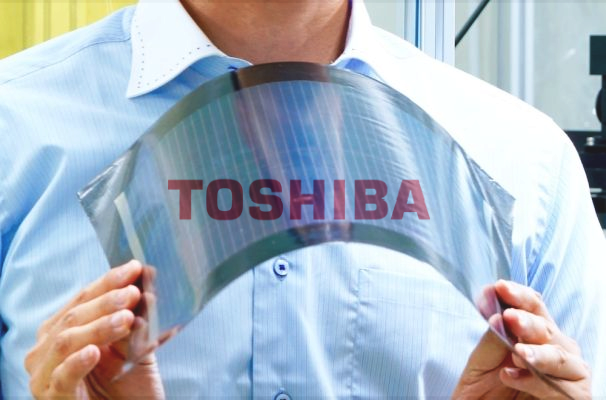Toshiba Corporation, the world-leader in development of perovskite photovoltaic modules for next-generation solar power generation, has developed a new coating method for the perovskite layer that boosts power conversion efficiency (PCE) to 15.1% for Toshiba’s 703cm2 module1, the highest for any large, polymer film-based perovskite photovoltaic module2.
The innovative coating method for perovskite layer also greatly reduces production time and costs, contributing to a lower cost for solar power generation.

Toshiba’s latest breakthrough is the development of a new perovskite layer coating method.
The company previously developed a two-step coating process that first applied a layer of PbI2 (lead iodide) ink to a substrate, followed by a layer of MAI (methyammonium iodide, CH3NH3I) ink, triggering a reaction that formed an MAPbI3 layer.
However, this multi-step approach had a low coating rate and often left unreacted sections in the perovskite layer (Figure 1, left). The alternative is a one-step process that applies MAPbI3 ink directly, but it is not easy to control crystallization of the MAPbI3 and obtain a uniform perovskite layer across a large area (Figure 1, right). A new coating method that solves these problems was required.

Toshiba has developed a one-step meniscus coating method that uses improved ink, film drying processes and production equipment to form a uniform perovskite layer over an area as large as 703cm2.
Applied to Toshiba’s previously reported 703cm2 polymer film-based perovskite photovoltaic modules, the one-step meniscus coating method achieves a PCE of 15.1%, the world’s highest ever for a polymer film-based large-area perovskite photovoltaic module.

(Figure 2, right). This higher PCE and the faster, simplified production process, significantly advance progress toward the commercialization of highly efficient, low-cost, polymer film-based perovskite photovoltaic modules.
Toshiba estimates that the new perovskite photovoltaic modules would generate power equivalent to two-thirds of the annual power consumption by homes in Tokyo*4 if installed on a roof area of 164.9km2, roughly equal to the roof surface area of all buildings in Tokyo*5.
This is a PR Newswire Feed; edited by Clean-Future Team






